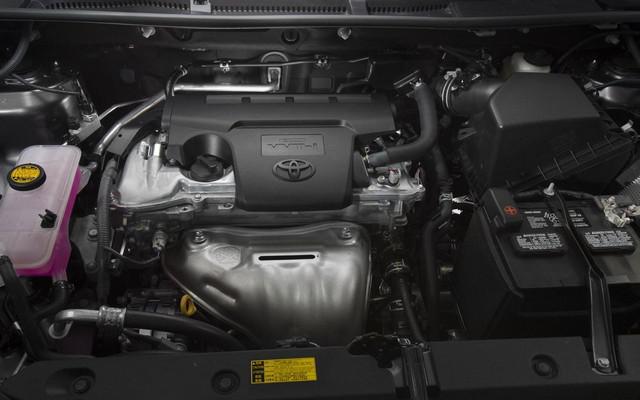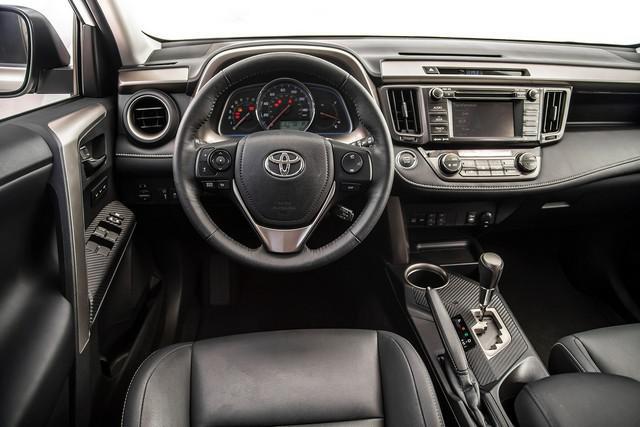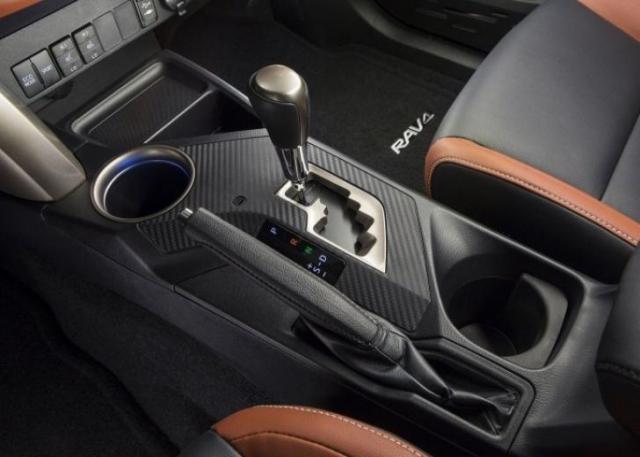Due to the fact that Toyota RAV4 technical characteristics are very attractive to potential owners, the demand for a car is always high. This is largely due to the versatility, durability, practicality and high comfort of this vehicle. The SUV received its name RAV4 as a result of the reduction of the full name - Recreation Active Vehicle 4.
Technical characteristics of the first generation of cars (1994-2000)
The car of the first version of the RAV 4, which was introduced in 1994, was a three-door short crossover with an original sports design. Outwardly, it resembled an off-road coupe. The dimensions of the machine at that time were 3705 mm long, 1695 mm wide, 1650 mm high. Clearance - 200 mm.
The main parameters of the crossover:
- wheelbase 2200 mm;
- total weight 1565 kg;
- trunk capacity of about 175-520 liters.
The first car was a great success: both young people and married couples were eager to get it. But, since the trial version was not practical enough, in 1995 an elongated car with five doors entered the market. Now the length of the car has increased by 41 centimeters. The luggage compartment has almost doubled in size.
Both versions of the first generation were equipped with one engine. It was a gasoline unit with a volume of 2 liters and a power value of 128 l / s. The torque value corresponded to 178 Nm with the achievement of 4600 rpm.
The Toyota RAV 4 had a fuel consumption of 7.7 liters on the highway and 12.3 liters in the urban area. It took 10.1 s to accelerate the SUV to 100 km/h. However, the choice of the consumer was offered two gearboxes: a solid five-speed mechanics and a trouble-free four-speed automatic, characterized by the presence of sports and economical modes.
In the first generation, the fourth RAV could be either all-wheel drive or front-wheel drive. It is known that the monodrive version had little demand, even at a lower cost. The four-wheel drive crossover was equipped with a so-called all-wheel drive (permanent) scheme with 50/50 torque redistribution between the drive axles.

Technical characteristics of the second generation of cars (2000-2005) year
In early 2000, an updated RAV 4 appeared on the markets. Understanding the importance of the car's compact dimensions and strengthening the quality of previous versions, the company's management helped the company's management to greatly increase sales of the new version. The redesigned appearance of Toyota has acquired individuality and solidity. Salon has become more spacious. Improved finish quality.
Overall dimensions of the body and the main components of the car with three doors:
- length parameter 3850 mm;
- width parameter 1785 mm;
- height parameter 1670 mm;
- tank capacity 58 liters;
- ground clearance 200 mm;
- gross weight 1595 kg;
- wheelbase 2280 mm;
- trunk capacity 150-766 liters.
Overall dimensions of the body and main components of a car with five doors:
- length parameter 4245 mm;
- width parameter 1785 mm;
- height parameter 1680 mm;
- tank capacity 58 liters;
- ground clearance 200 mm;
- gross weight 1700 kg;
- wheelbase 2490 mm;
- trunk capacity 400-1150 liters.
The main technical characteristics of the Toyota RAV 4 expressively indicate an increase in the dimensions of the car. The younger version has become larger than 14.5 centimeters, the older version has been enlarged by 13 centimeters. The width parameters have changed quite a bit. You can even say that they have remained almost the same.

The variety of engines that the car was equipped with was also increased:
- a motor with a capacity of 1.8 liters, a return of 125 l / s and a torque value of 161 Nm, was most often installed on the “short” version instead of a 2-liter unit. Despite a slight loss in power, fuel economy has become significant: 9.4 liters - city, 6.2 liters - highway. A characteristic feature of this version was the uncontested front-wheel drive;
- motor with a capacity of 2.0 liters with a power parameter of 150 l / s, and a torque value of 192 Nm. Such a powerful engine was very dynamic (acceleration of the car to 100 km / h was achieved in 10.6 s) and economical - fuel consumption in the city was 11.4 liters, while on the highway - 7.3 liters;
- a 2.0-liter engine (diesel version) had a power of 116 l / s. The torque parameter is 250 Nm from just 1800 rpm. Such a diesel engine was the first to be installed on the RAV 4. Naturally, it was inferior to gasoline tractors in dynamics, but off-road it was the best pusher. Diesel fuel consumption: 9.9 l - city, 6.1 l - highway;
- gasoline engine with a capacity of 2.4 liters with a torque parameter of 224 Nm and a power value of 167 l / s. It took 9 seconds to accelerate to the 100 km defined by the standard. At the same time, fuel consumption was 10% more than that of the 150-horsepower version. Such an engine was completed only with a 4-speed automatic.
All petrol versions were equipped with mechanics or automatic, starting from the first generation of the car. Diesel engines were equipped only with mechanics. Toyota RAV 4 in 2004 underwent a slight restyling. The shape of both bumpers has undergone a change, and the radiator grille has also changed. However, the main feature was the appearance of a new 2.4-liter engine.
Technical characteristics of the third generation of cars (2005-2009)
Released in 2005, Toyota RAV 4 - the technical characteristics were completely different from the models of previous versions. The car was built on a completely new platform, eliminating the possibility of a three-door configuration and providing more space for a five-door version. All interior details had a rich look.
Dimension of the body and main components:
- wheelbase - 2560 mm;
- body: length - 4.395 m, width - 1.815 m, height -1.685 m, ground clearance - 190 mm;
- gross weight 2070 kg;
- curb weight 1500 kg;
- trunk capacity 586-1469 l.
In addition to the technical parameters, the electronics have also undergone changes. An optotronic branded backlight appeared in the car, the engine could be started without a key, the tape recorder became able to read the mp3 format, the display was equipped with a Russified version. Careful study by Toyota engineers of the issue of the security system led to the appearance in the RAV 4 basic version of seven airbags at once.
As a result of the increase in the size of the car, there is more space in the cabin. From the total increase, the back row received as much as 55 mm, which significantly affected the comfort.
The improved 2-liter engine has acquired two boost levels - 152 and 158 l / s with the same torque value of -198 Nm. In dynamism, the RAV 4 motors did not differ much. The acceleration of the heavier crossover took 10.2 and 11 s. This indicator depended on the type of transmission - mechanics or a 4-speed automatic. The stepless version was with 158 l / s.
In the third generation, all versions of the car were all-wheel drive or front-wheel drive. The exception was the versions with the engine 2.4 and 3.5. They were equipped with a drive to all four wheels at once by default.
It was the third generation of RAV4 that was marked by the loss of the permanent all-wheel drive function. Since then, the car has been equipped with a plug-in system, which means the possibility of an electronically controlled connection of the rear axle when the front wheels slip. The driver can engage the 4-wheel drive at will. To do this, just press the button for forced activation of the all-wheel drive.
Due to the fact that the entire system is subject to increased wear when driving on a flat track (largely due to the presence of a delicate viscous coupling), the coupling was equipped with a temperature sensor to avoid breakdowns. Now, as soon as the temperature value on the device becomes very high, the rear drive is turned off. When driving at speeds exceeding 40 km/h, the rear wheels are also disabled.

Technical characteristics of the fourth generation of cars (2009-2012)
For the new generation Toyota RAV 4, the previous platform was taken as the basis. However, the design has gotten better. There was a rich optional set, a CD changer for 6 discs, an innovative dual-zone climate control, R 17 alloy wheels, a third row of seats. Models in two variations of the engine entered the domestic market: 2.0 and 2.4.
Now the car had the following technical characteristics:
- wheelbase - 2560 mm;
- tank capacity 60 liters;
- weight: curb -1500 kg, full - 2070 kg;
- trunk capacity 410-1320 l.
The fourth generation was marked by the appearance of an elongated version - Long. It was larger than the standard modification. All cars of the 4th generation were equipped with a 6-speed manual, as well as a stepless variator of the Multi Drive-S model. The extended version was equipped with a four-speed automatic. It was possible to order all-wheel drive for any version, with the exception of the base one with a 2 liter engine.
Vehicle specifications from 2013
The exhibition in Los Angeles in 2013 was marked by the appearance of a new generation of Toyota RAV 4. The crossover was based on a long-tested platform from the already familiar version of Long. The concept of the design direction has undergone cardinal changes. The new corporate identity was a continuation of the direction set by the 2011 Avensis sedan.
Specifications of the new car:
- clearance - 197 mm;
- length parameter - 4570 mm;
- width parameter - 1845 mm;
- height parameter - 1670 mm;
- trunk volume Toyota RAV 4 - 506-1705 l;
- tank capacity 60 l;
- weight 2000 kg;
- wheelbase - 2660 mm.
From the roadway, the new car rose another 7 mm. Trunk volume has become somewhat smaller, but nevertheless comparable to the luggage compartment of a D-class sedan. In addition, there are more unified elements between the Toyota RAV 4 models themselves. The most powerful engine in the trim levels is a 2.5 liter engine.
There are three power units in the 2013 model range. The first option is a 2.0 liter engine with a capacity of 146 l / s. Torque value 187 Nm. This is not the first time such an engine has been installed on the RAV 4. Now it has been reconfigured for greater fuel economy. Acceleration to a hundred kilometers is 10.2 seconds. The basic equipment assumes a mechanical 6-speed gearbox. For a certain surcharge, you can make a variator.
Another type is a 2.2 liter engine. Diesel modification is characterized by a capacity of 150 l / s. Torque - 340 Nm. An engine of this type is equipped exclusively with an automatic 6-speed gearbox and is the first diesel engine officially sold in Russia. Acceleration to 100 km RAV 4 spends 10 seconds. Fuel consumption in the city is only 8.1 liters, on the highway - 5.5 liters.
The third variation of the engine is a unit with a volume of 2.5 liters and a power parameter of 180 l / s. The torque corresponds to 233 Nm. This Rafik engine inherited from the new Toyota Camry model, including a 6-speed transmission. Acceleration to 100 km is already possible in 9.4 s. Fuel consumption: 11.4 liters - city, 6.8 liters - highway.

Prices for the Toyota RAV4 lineup
In Russia, the appearance of the new Toyota RAV 4 model took place on February 23, 2013. At the same time, all eight trim levels became available. The price range started from 998,000 rubles and ended within 1,543,000 rubles:
- standard modification - 998 thousand rubles. Front wheel drive car with manual transmission. The volume of the engine is 2.0 liters. There is air conditioning, a headlight washer, an immobilizer, an audio system of 4 speakers, LED DRLs and Bluetooth, a full-size spare wheel, a set of mudguards, heated seats, 7 airbags, central locking with remote control, full power windows, ABS, EBD, 17th steel discs. Electronic simulation of cross-axle differential;
- modification standard plus - 1 million 55 thousand rubles. Engine - 2.0 liters. Front wheel drive version with CVT. Additional options: rear parking sensors, leather-trimmed steering wheel;
- modification comfort - 1 million. 180 thousand rubles. All-wheel drive car with manual transmission. The volume of the engine is 2.0 liters. Of the new options - cruise control, 6.1-inch color display, rain sensor, light, dual-zone climate control, leather front panel, rear view camera, 6-speaker audio system, VSC + directional stability function;
- comfort plus modification - 1 million 248 thousand rubles. All-wheel drive car with a variator (2.0 l). Additional equipment: function of the help on descent, xenon headlights;
- elegans modification - 1 million 355 thousand rubles. All-wheel drive car with CVT or automatic transmission. Engine with a volume of 2.0 liters, as well as 2.2 liters (diesel). Additions: folding and heated rear-view mirrors, keyless entry to the salon, activation of the car with a button, full leather interior, power tailgate, additional heater (in the diesel model);
- elegans plus modification - 1 million rubles 470 thousand rubles. All-wheel drive with automatic transmission (2.5 l). The option is similar to the elegans configuration;
- prestige modification - 1 million 438 thousand rubles. All-wheel drive with CVT or automatic transmission. The volume of the engine is 2.0 liters or 2.2 liters (diesel). Additions: automatic high beam system, voice control function, navigation system with Russification, blind spot monitoring function;
- modification prestige plus - 1 million 543 thousand rubles. All-wheel drive with automatic transmission (2.5 l). The options are similar to the Prestige package.
Today, a car equipped with all-wheel drive, as well as independent suspension of a monocoque body and wheels, compares favorably with excellent handling performance and a high level of comfort. In addition, the sporty spirit of the Toyota RAV4 is felt in every element. The car easily overcomes off-road and behaves quite smartly on the highway.
